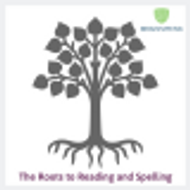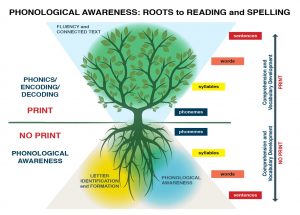The Roots to Reading and Spelling
Posted by Angelina Spiteri-Bender on 24th Jan 2019
Phonological awareness is the foundation we lay for our students to become successful readers and spellers. If we were building a house, baking a cake, or planting a tree, we would first take the preliminary measures to ensure the end result will be promising. We would want the right ingredients to bake that cake, right? Same goes for teaching our students to read and spell. Many times, instruction in these oral and auditory skills were somehow missed, maybe even taught too quickly. Some students seem to have it mastered one day, only to demonstrate multiple inaccuracies the next. This could be the missing piece to an oh so confusing puzzle.
Reading and Spelling Require Strong Roots
Another way to look at this is via the tree example below. In this model, reading and spelling are represented by the top bushy parts of the tree. Imagine the roots are Phonological Awareness skills. If the tree grows tall and strong, it’s due to its healthy roots. This is a healthy tree that is reading and spelling wonderfully because it mastered phonological awareness skills. Reading and spelling can, therefore, be learned and enjoyed. As you look at the diagram below, think to yourself how strong your students’ phonological awareness roots are. Maybe this is an area that has been ignored for a while (we are all trying our best!). Regardless of age or grade level, these roots in reading and spelling must be strong.
Do you notice some of your students exhibiting weakness in sounding words out? Maybe spelling? This could be due to a weak root in orally blending/segmenting sounds. We may have to tend to that underlying root and strengthen it. Once strengthened, you will find your efforts were well worth the time. After explicit instruction in these identified “weak roots,” orally blending sounds may feel more automatic. Hearing individual sounds in words may help to spell the word more easily.
But what if we determine we have to go way back? What if you have a third grader who is unsure of what a syllable is or a student who struggles to find patterns and rhyme in words? Who really stumbles and feels overwhelmed and flustered by the task of reading a sentence? Well, just think. As fast-paced as the weeks, months and years can be, imagine how much MORE this child will be behind if we don’t go back and fill in these gaps. It will take some hard work, but the longer we wait, the harder it will be to rewind. Many students compensate and try their best to get by. They may even pass tests and demonstrate mediocre reading. Compensating only lasts so long. We don’t want to get to this point!
Earlier this month we posted an article outlining each piece of Phonological Awareness. If you missed it and are interested, click below.
Enjoy!
Written by Angelina Spiteri-Bender
Angelina is an Educational Consultant and Instructor with Brainspring Educator Academy.
Click here to learn more about our accredited Orton-Gillingham professional development.


